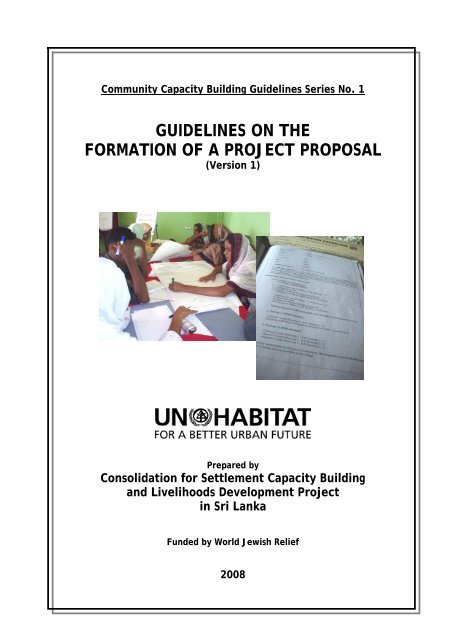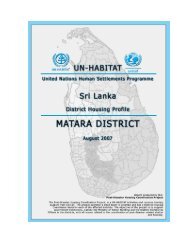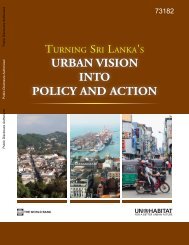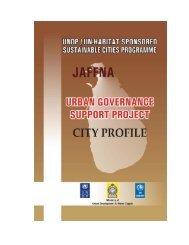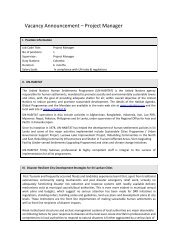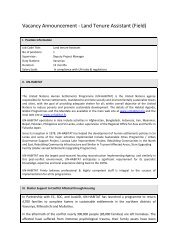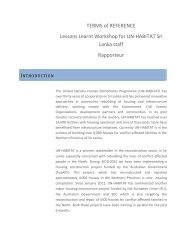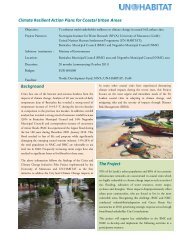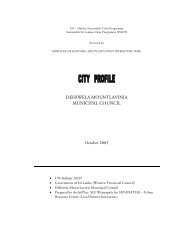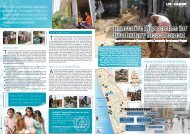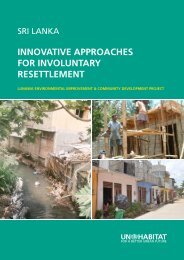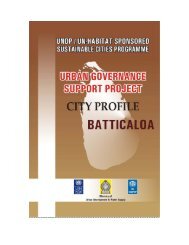guidelines on the formation of a project proposal - UN HABITAT
guidelines on the formation of a project proposal - UN HABITAT
guidelines on the formation of a project proposal - UN HABITAT
Create successful ePaper yourself
Turn your PDF publications into a flip-book with our unique Google optimized e-Paper software.
Community Capacity Building Guidelines Series No. 1GUIDELINES ON THEFORMATION OF A PROJECT PROPOSAL(Versi<strong>on</strong> 1)Prepared byC<strong>on</strong>solidati<strong>on</strong> for Settlement Capacity Buildingand Livelihoods Development Projectin Sri LankaFunded by World Jewish Relief2008
C<strong>on</strong>tents1.0 Introducti<strong>on</strong> 12.0 The need for a <strong>project</strong> <strong>proposal</strong> 13.0 Basic comp<strong>on</strong>ents <strong>of</strong> a <strong>project</strong> <strong>proposal</strong> 23.1 Name <strong>of</strong> <strong>the</strong> <strong>project</strong> 23.2 Project prop<strong>on</strong>ent 23.3 Partners 23.4 Project area 23.5 Project beneficiaries 23.6 Need for <strong>the</strong> <strong>project</strong> 23.7 Objectives <strong>of</strong> <strong>the</strong> <strong>project</strong> 33.8 Project activities 33.9 Expected results 33.10 Cost estimate 33.11 Time frame 43.12 Progress review and reporting 43.13 Project evaluati<strong>on</strong> 44.0 Points to be c<strong>on</strong>sidered in submitting a <strong>project</strong> <strong>proposal</strong>to a funding instituti<strong>on</strong> 4Annex I Sample <strong>of</strong> Project Proposal 5Annex II Agenda <strong>of</strong> Workshop <strong>on</strong> Proposal Writing 10Photos <strong>on</strong> <strong>the</strong> cover page:1) Proposal wiring workshop (Ampara District)2) Drainage rehabilitati<strong>on</strong> <strong>proposal</strong> prepared by a CDC in Jaffna District
1.0 Introducti<strong>on</strong>The objective <strong>of</strong> this guideline is to create awareness am<strong>on</strong>g community leadersand mobilizers interested in <strong>the</strong> formulati<strong>on</strong> <strong>of</strong> a simple <strong>project</strong> <strong>proposal</strong> necessaryto be presented to raise funds for a community development council (CDC)established in a low income settlement. The funds raised will be used for <strong>the</strong>implementati<strong>on</strong> <strong>of</strong> some activities identified by <strong>the</strong> community <strong>of</strong> <strong>the</strong> settlement.2.0 The need for a <strong>project</strong> <strong>proposal</strong>In urban areas <strong>of</strong> Sri Lanka, <strong>the</strong>re are settlements occupied predominantly by lowincome earners. Half <strong>of</strong> <strong>the</strong> populati<strong>on</strong> <strong>of</strong> <strong>the</strong> city <strong>of</strong> Colombo, comprise <strong>of</strong> <strong>the</strong>m.They live in <strong>the</strong>se densely populated settlements without adequate basicamenities. The problems <strong>of</strong> such settlements get aggravated day by day. Thecomplexity and acuteness <strong>of</strong> <strong>the</strong>m are such that no government or n<strong>on</strong>governmentalorganizati<strong>on</strong>s (NGOs) have been able to address <strong>the</strong>m successfully.Villages and rural settlements too have <strong>the</strong>ir inherent problems. They were fur<strong>the</strong>raggravated by <strong>the</strong> tsunami disaster in 2004.These problems still exist, though <strong>the</strong>irnature has witnessed changes in many fr<strong>on</strong>ts.Although government and NGOs extended financial aid for tsunami <strong>project</strong>s ando<strong>the</strong>rs to provide basic facilities including housing in <strong>the</strong>se settlements andvillages, due to limitati<strong>on</strong>s in such funding some essential work remainunimplemented.Thus various districts have a large number <strong>of</strong> low income settlements crying forbasic amenities. There are active as well as inactive community councils in <strong>the</strong>sesettlements.Due to lack <strong>of</strong> funds and ignorance about ways and means <strong>of</strong> raising funds, <strong>the</strong>seCDCs are stuck with <strong>the</strong>ir problems creating dependency. Community leaders makerequests for assistance from government and NGOs and also from <strong>the</strong> local politicalleadership and live with <strong>the</strong> hope that <strong>the</strong>ir requests will be granted early. Thisdependency <strong>on</strong> external agencies <strong>of</strong>ten results in dashing <strong>of</strong> <strong>the</strong>ir expectati<strong>on</strong>s.Creati<strong>on</strong> <strong>of</strong> <strong>the</strong> background required for fulfilling <strong>the</strong> needs <strong>of</strong> <strong>the</strong> communitythrough CDCs is <strong>the</strong> <strong>on</strong>ly soluti<strong>on</strong> to this problem. This can be d<strong>on</strong>e by identifying<strong>the</strong> basic requirements <strong>of</strong> <strong>the</strong> community and finding <strong>the</strong> means to meet <strong>the</strong>m. Itwill be very easy for a CDC to formulate a <strong>project</strong> <strong>proposal</strong> and present it to afunding instituti<strong>on</strong> seeking funds to provide <strong>the</strong>se facilities.The <strong>project</strong> can be implemented subsequently by following <strong>the</strong> “communityc<strong>on</strong>tracting” method 1 .1Implementing an activity by a CDC after entering into a c<strong>on</strong>tract with <strong>the</strong> relevantparties is referred to as <strong>the</strong> community c<strong>on</strong>tracting method. The <strong>of</strong>fice bearers <strong>of</strong> <strong>the</strong>CDC play a leading role in this activity.1
3.0 Basic comp<strong>on</strong>ents <strong>of</strong> a <strong>project</strong> <strong>proposal</strong>Project <strong>proposal</strong>s can be implemented at several levels. However this guideline isc<strong>on</strong>cerned with <strong>the</strong> methodology for <strong>the</strong> preparati<strong>on</strong> <strong>of</strong> a simple <strong>project</strong> <strong>proposal</strong>to be formulated by <strong>the</strong> community to raise finances to implement <strong>the</strong> activities <strong>of</strong><strong>the</strong> CDC <strong>of</strong> a low income community. It should be a <strong>proposal</strong> which invariably fulfils<strong>the</strong> requirements <strong>of</strong> <strong>the</strong> community and is beneficial to <strong>the</strong>m.3.1 Name <strong>of</strong> <strong>the</strong> <strong>project</strong>The name <strong>of</strong> <strong>the</strong> <strong>project</strong> should provide some informati<strong>on</strong> with respect toits objective. Expressi<strong>on</strong> <strong>of</strong> <strong>the</strong> activities /objectives through its name willmake it possible for <strong>the</strong> <strong>project</strong> to become more fruitful.3.2 Project prop<strong>on</strong>entProject prop<strong>on</strong>ent is <strong>the</strong> party that presents <strong>the</strong> <strong>proposal</strong> to <strong>the</strong> FundingInstituti<strong>on</strong>. In this instance it is <strong>the</strong> CDC. The name <strong>of</strong> <strong>the</strong> CDC should beindicated very clearly. The District and <strong>the</strong> Divisi<strong>on</strong>al Secretary’s Divisi<strong>on</strong>should also be clearly indicated.3.3 PartnersPartners in <strong>the</strong> proposed <strong>project</strong> should be clearly indicated in this secti<strong>on</strong>.The funding instituti<strong>on</strong> to which a <strong>project</strong> <strong>proposal</strong> is being submitted isidentified as <strong>on</strong>e <strong>of</strong> <strong>the</strong> partners.3.4 Project areaProject area should be clearly specified by indicating <strong>the</strong> name <strong>of</strong> <strong>the</strong>settlement and administrative area.3.5 Project beneficiariesNumber <strong>of</strong> expected beneficiaries is important informati<strong>on</strong> for <strong>the</strong> proposed<strong>project</strong>. Number <strong>of</strong> households or individuals who will benefit from <strong>the</strong><strong>project</strong> is written here. In some <strong>project</strong>s, <strong>the</strong> entire members <strong>of</strong> a CDCbecome <strong>the</strong> beneficiaries. In o<strong>the</strong>r <strong>project</strong>s, <strong>the</strong> selected member <strong>of</strong> a CDC,such as most vulnerable people like widows, become <strong>the</strong> beneficiaries. In<strong>the</strong> latter cases, selecti<strong>on</strong> criteria <strong>of</strong> <strong>the</strong> beneficiaries should be included inthis secti<strong>on</strong>.3.6 Need for <strong>the</strong> <strong>project</strong>The need for <strong>the</strong> <strong>project</strong> should be clearly sated by explaining <strong>the</strong> followingpoints: The current issue/s in <strong>the</strong> <strong>project</strong> area Steps taken so far to address <strong>the</strong> issues The need to implement this <strong>project</strong>2
3.7 Objectives <strong>of</strong> <strong>the</strong> <strong>project</strong>Main objectives <strong>of</strong> <strong>the</strong> <strong>project</strong> should be listed clearly in this secti<strong>on</strong>.3.8 Project activitiesHere we have to clearly state <strong>the</strong> specific activities to achieve <strong>the</strong> abovementi<strong>on</strong>edobjectives. The instituti<strong>on</strong>s resp<strong>on</strong>sible for each activity are alsostated in this secti<strong>on</strong>. The following table can be made use <strong>of</strong> for it.Objectives Activities Resp<strong>on</strong>sibilities3.9 Expected resultsHere we have to state <strong>the</strong> end product (= expected results) <strong>of</strong> each activity.It is recommendable to set “indicators” to measure <strong>the</strong> achievement <strong>of</strong>“expected results”. The indicator will be useful for m<strong>on</strong>itoring andevaluating <strong>the</strong> performance <strong>of</strong> <strong>the</strong> <strong>project</strong>. The following table can be puttoge<strong>the</strong>r with <strong>the</strong> above table, and named as “Plan <strong>of</strong> Activities”.Activities Expected results Indicators3.10 Cost estimateThis refers to <strong>the</strong> expenditure expected to be incurred for implementing <strong>the</strong><strong>project</strong>. The important fact to be borne in mind is that funds should berequested from <strong>the</strong> funding instituti<strong>on</strong> <strong>on</strong>ly in respect <strong>of</strong> <strong>the</strong> absolutelyessential items <strong>of</strong> <strong>the</strong> <strong>project</strong>. C<strong>on</strong>tributi<strong>on</strong> from <strong>the</strong> CDC should beitemized separately as land, labour, building etc. Value <strong>of</strong> <strong>the</strong>se should alsobe added to <strong>the</strong> cost estimate. The following table can be used for this. Thec<strong>on</strong>tributi<strong>on</strong> from partner agencies should also be indicated.ActivitiesC<strong>on</strong>tributi<strong>on</strong>by <strong>the</strong> CDC(LKR)C<strong>on</strong>tributi<strong>on</strong> bypartner agency –A(LKR)C<strong>on</strong>tributi<strong>on</strong> bypartner agency-B(LKR)Total Cost(LKR)3
3.11 Time frameTime frame for each activity should be clearly indicated. This should beprepared in c<strong>on</strong>sultati<strong>on</strong> with o<strong>the</strong>r stakeholders. Following table can bemade use for it.ActivitiesTime FrameJan Feb Mar Apr May June July Aug Sept3.12 Progress review and reportingProcedure for reviewing progress and for reporting progress should beclearly described. The period for which reports are prepared may beidentified as m<strong>on</strong>thly, quarterly etc. The manner in which progress reportsetc are to be sent to <strong>the</strong> funding instituti<strong>on</strong> should be described in thissecti<strong>on</strong>. Steps to be taken in respect <strong>of</strong> any shortcomings observed during<strong>the</strong> reviewing <strong>of</strong> progress should also be indicated.3.13 Project evaluati<strong>on</strong>To measure <strong>the</strong> success <strong>of</strong> a <strong>project</strong>, it is necessary to carry out anevaluati<strong>on</strong>. By c<strong>on</strong>sidering <strong>the</strong> <strong>project</strong> objectives, results, positive andnegative impacts, it will be possible to identify <strong>the</strong> success, shortcomingsand specifically less<strong>on</strong>s learnt. The way <strong>of</strong> evaluati<strong>on</strong> should be indicatedin <strong>the</strong> <strong>proposal</strong>.4.0 Points to be c<strong>on</strong>sidered in submitting a <strong>project</strong> <strong>proposal</strong> to a funding instituti<strong>on</strong>The <strong>project</strong> <strong>proposal</strong> formulated by <strong>the</strong> CDC can be submitted to a fundinginstituti<strong>on</strong>. However <strong>the</strong> CDC should not act <strong>on</strong> <strong>the</strong> premise that <strong>the</strong> fundinginstituti<strong>on</strong> will extend financial assistance <strong>on</strong> <strong>the</strong> mere presentati<strong>on</strong> <strong>of</strong> a <strong>proposal</strong>.(1) Formulate <strong>proposal</strong>s to suit <strong>the</strong> requirements <strong>of</strong> a funding instituti<strong>on</strong>.CDCs should be aware that <strong>the</strong>re are norms adhered to by a fundinginstituti<strong>on</strong>. When <strong>the</strong> <strong>project</strong> <strong>proposal</strong> is presented to a funding instituti<strong>on</strong>,<strong>the</strong>y will c<strong>on</strong>sider whe<strong>the</strong>r it has been formulated in a manner that satisfiesits requirements as well as those <strong>of</strong> <strong>the</strong> main funding sources. If <strong>the</strong>y do notmeet <strong>the</strong> requirements fully, <strong>the</strong> <strong>project</strong> <strong>proposal</strong> will ei<strong>the</strong>r be rejected orinstructi<strong>on</strong> will be given to amend it.Rejecti<strong>on</strong> will be inevitable when <strong>the</strong>re is failure to provide informati<strong>on</strong> asrequired. It is important that <strong>the</strong> formulati<strong>on</strong> <strong>of</strong> <strong>the</strong> <strong>project</strong> <strong>proposal</strong> iscarried out after obtaining appropriate advice from a knowledgeable pers<strong>on</strong>.If possible, it is useful to discuss with an appropriate <strong>of</strong>ficer from <strong>the</strong> funding4
instituti<strong>on</strong> and to obtain <strong>the</strong> necessary informati<strong>on</strong> before formulating <strong>the</strong><strong>proposal</strong>.Some instituti<strong>on</strong>s have standard formats for presentati<strong>on</strong> <strong>of</strong> <strong>project</strong><strong>proposal</strong>s. In such instances invariably such forms have to be used.(2) Refrain from objecti<strong>on</strong>s or reacting emoti<strong>on</strong>ally in case <strong>of</strong> refusalThe general resp<strong>on</strong>se <strong>of</strong> a CDC to a rejecti<strong>on</strong> <strong>of</strong> a <strong>project</strong> <strong>proposal</strong> is reactingwith anger and protesting about <strong>the</strong> decisi<strong>on</strong>. Reacting emoti<strong>on</strong>ally to arefusal may result in losing <strong>the</strong> opportunity to obtain assistance from <strong>the</strong>instituti<strong>on</strong> in <strong>the</strong> future.Therefore <strong>the</strong> leaders who are delegated to discuss with <strong>the</strong> fundinginstituti<strong>on</strong> should invariably be individuals with understanding, patience,knowledge and wisdom. What should happen is not to resp<strong>on</strong>d by raisingobjecti<strong>on</strong>s or protest at <strong>the</strong> o<strong>the</strong>r party, but to bring <strong>the</strong> <strong>proposal</strong> to a state<strong>of</strong> being accepted for funding by identifying any shortcomings and byrectifying <strong>the</strong>m or presenting it to ano<strong>the</strong>r instituti<strong>on</strong>.5
Annex I: Sample <strong>of</strong> Project Proposal1. Name <strong>of</strong> <strong>the</strong> <strong>project</strong>: Solid Waste Management Project for Galle District2. Project prop<strong>on</strong>ent: Walauwatte Community Development Council (CDC)in Galle Divisi<strong>on</strong>al Secretary’s Divisi<strong>on</strong>, Galle District3. Partners:(1) Central Envir<strong>on</strong>mental Authority (Waste Management Project)(2) Department <strong>of</strong> Agriculture4. Project area: Walauwatte Community Development Council (CDC) in GalleD.S. Divisi<strong>on</strong>, Galle District5. Project beneficiaries: 250 households in <strong>the</strong> Walauwatte CDC6. Need for <strong>the</strong> <strong>project</strong>:Walauwatte CDC located in Galle D.S. Divisi<strong>on</strong>, Galle District is a low incomesettlement with high density <strong>of</strong> populati<strong>on</strong>. The local government authority, namelyGalle Municipal Council, does not have a proper system for collecting <strong>of</strong> <strong>the</strong> waste insettlements. As a result, garbage gets accumulated as big dumps in various placeswhich become breeding grounds for flies and mosquitoes. The residents have to face<strong>the</strong> inc<strong>on</strong>venience <strong>of</strong> <strong>the</strong> stench as well as health problems arising from <strong>the</strong>unhygienic c<strong>on</strong>diti<strong>on</strong>s.Walauwatte CDC requested Galle Municipal Council to deliver a proper service to solve<strong>the</strong> above issue. However, <strong>the</strong> Municipal Council did not have an immediate countermeasure.<strong>UN</strong>-<strong>HABITAT</strong> introduced <strong>the</strong> CDC to <strong>the</strong> Waste Management Project by <strong>the</strong> CentralEnvir<strong>on</strong>mental Authority (CEA). The CDC decided to write a <strong>proposal</strong> to <strong>the</strong> CEA toassist <strong>the</strong> CDC in establishing a waste management programme within <strong>the</strong> settlement.7. Objectives <strong>of</strong> <strong>the</strong> <strong>project</strong>:This <strong>project</strong> is formulated to achieve <strong>the</strong> following objectives.(1) Create awareness am<strong>on</strong>g <strong>the</strong> community regarding a solid waste managementprogramme, and train <strong>the</strong>m <strong>on</strong> sorting out <strong>the</strong> waste.(2) Introduce bio-degradable waste management by training in composting <strong>the</strong> wasteand making use <strong>of</strong> it for home gardening.(3) Introduce n<strong>on</strong>-degradable waste management by establishing a system <strong>of</strong> sorting<strong>the</strong> waste and selling to buyers.(4) Create awareness am<strong>on</strong>g school children about <strong>the</strong>se programmes and make<strong>the</strong>m participate in implementati<strong>on</strong>.6
8. Plan <strong>of</strong> Activities:Objectives Activities Resp<strong>on</strong>sibilities Expected results Indicators(1) Creating awareness <strong>on</strong>a solid wastemanagementprogramme(1-1): C<strong>on</strong>duct 2 workshops forawareness raising am<strong>on</strong>g <strong>the</strong>CDC members• CentralEnvir<strong>on</strong>mentalAuthority• Walauwatte CDC• CDCs understand <strong>the</strong>need and for sortingout solid waste andhow to do it.• No. <strong>of</strong> participants <strong>of</strong> <strong>the</strong>workshops will be not lessthan 150.(2) Introducing biodegradablewastemanagement(2-1): C<strong>on</strong>duct a training programme<strong>on</strong> how to use compost bins(2-2): Provide 100 compost bins(2-3): C<strong>on</strong>duct a training programme<strong>on</strong> home gardening by usingcompost made from biodegradablewaste(2-4): Supply seeds and seedlings to<strong>the</strong> beneficiaries• CentralEnvir<strong>on</strong>mentalAuthority• Walauwatte CDC• Department <strong>of</strong>Agriculture• Bio-degradable wasteis not dumped butc<strong>on</strong>verted tocompost.• Beneficiaries growplants by using <strong>the</strong>compost.• Decrease in <strong>the</strong> amount <strong>of</strong>bio-degradable waste dumpedin open areas• No. <strong>of</strong> compost binsdistributed• No. <strong>of</strong> compost bins utilized• No. <strong>of</strong> households engaged inhome-gardening(3) Introducing n<strong>on</strong>degradablewastemanagement(3-1) Introduce buyers to <strong>the</strong>community by c<strong>on</strong>ducting twospecial meetings(3-2) Provide <strong>the</strong> bags to sort outplastic, poly<strong>the</strong>ne and bins.• CentralEnvir<strong>on</strong>mentalAuthority• Walauwatte CDC• C<strong>on</strong>versi<strong>on</strong> <strong>of</strong> n<strong>on</strong>degradablewaste tocash• Decrease in <strong>the</strong> amount <strong>of</strong>n<strong>on</strong>-degradable wastedumped in open areas• Income <strong>of</strong> households byselling n<strong>on</strong>-degradable wasteto buyers(4) Creating awarenessam<strong>on</strong>g school children(4-1) C<strong>on</strong>duct <strong>on</strong>e special meeting tocreate awareness am<strong>on</strong>gchildren in <strong>the</strong> community(4-2) Hold an essay competiti<strong>on</strong>• CentralEnvir<strong>on</strong>mentalAuthority• Walauwatte CDC• Children understand<strong>the</strong> importance <strong>of</strong>solid wastemanagement• No. <strong>of</strong> participants <strong>of</strong> meetingwill be not less than 100.• Level <strong>of</strong> understanding7
9. Cost estimateActivities(1-1) C<strong>on</strong>duct 2 workshops forawareness raising am<strong>on</strong>g<strong>the</strong> CDC membersCommunityC<strong>on</strong>tributi<strong>on</strong>(LKR)CentralEnvir<strong>on</strong>mental Authority(LKR)Department<strong>of</strong>Agriculture(LKR)Total Cost(LKR)2.000.00 30,000.00 32,000.00(2-1) C<strong>on</strong>duct a training1,000.00 15,000.00 16,000.00programme <strong>on</strong> how to usecompost bins(2-2) Provide 100 compost bins 230,000.00 230,000.00(2-3) C<strong>on</strong>duct a training1,000.00 15,000.00 16,000.00programme <strong>on</strong> homegardening by using compost(2-4) Supply seeds and seedlings100,000.00 100,000.00to <strong>the</strong> beneficiaries(3-1) Introduce buyers to <strong>the</strong>500.00 10,000.00 10,500.00community by c<strong>on</strong>ductingtwo special meetings(3-2) Provide <strong>the</strong> bags to sort out25,000.00 25,000.00plastic, poly<strong>the</strong>ne and bins(4-1) C<strong>on</strong>duct <strong>on</strong>e special500.00 10,000.00 10,500.00meeting to createawareness am<strong>on</strong>g childrenin <strong>the</strong> community(4-2) Hold an essay competiti<strong>on</strong> 1,000.00 1,000.00Total cost for each instituti<strong>on</strong> 6,000.00 320,000.00 115,000.00 441,000.0010. Time frame:Year 2008Activities Jul Aug Sep Oct Nov Dec(1-1) ...... X(2-1) ...... X(2-2) ...... X(2-3) X(2-4) X(3-1) X(3-2) X(4-1) X(4-2) X X8
11. Progress review and reporting:• The secretary <strong>of</strong> Walauwatte CDC is resp<strong>on</strong>sible to review <strong>the</strong> progress <strong>of</strong> <strong>the</strong><strong>project</strong> m<strong>on</strong>thly.• The secretary <strong>of</strong> <strong>the</strong> Walauwatte CDC is resp<strong>on</strong>sible to report <strong>the</strong> progress <strong>of</strong> <strong>the</strong>programme to <strong>the</strong> funding instituti<strong>on</strong> m<strong>on</strong>thly.• The reporting items include <strong>the</strong> followings: Progress <strong>of</strong> activities (Plan and Actual) Expenditure Difficulties faced12. Project evaluati<strong>on</strong>:• Up<strong>on</strong> <strong>the</strong> completi<strong>on</strong> <strong>of</strong> <strong>the</strong> <strong>project</strong>, <strong>the</strong> CDC <strong>of</strong>fice bearers will c<strong>on</strong>duct anevaluati<strong>on</strong>.• Achievement <strong>of</strong> objectives will be measured by checking <strong>the</strong> “Indicators” writtenin <strong>the</strong> “Plan <strong>of</strong> Activities”.• Through a discussi<strong>on</strong> with <strong>the</strong> CDC members, any issues and countermeasure willbe discussed.9
Annex II: Agenda <strong>of</strong> Workshop <strong>on</strong> Proposal WritingTimeActivity09.00 a.m. - 09.10 a.m. Welcome speech09.10 a.m. - 09.20 a.m. Self introducti<strong>on</strong>09.20 a.m. - 09.30 a.m. Objective <strong>of</strong> <strong>the</strong> workshop09.40 a.m. - 10.10 a.m. Need for a <strong>project</strong> <strong>proposal</strong>10.10 a.m. - 10.30 a.m. Tea10.30 a.m. - 1.00 p.m. 13 steps <strong>of</strong> <strong>proposal</strong> formulati<strong>on</strong>Break into 3 groups and prepareA draft <strong>proposal</strong>01.00 p.m. - 01.30 p.m. Presentati<strong>on</strong> by groups01.30 p.m. - 01.45 p.m. Discussi<strong>on</strong> and winding up10


